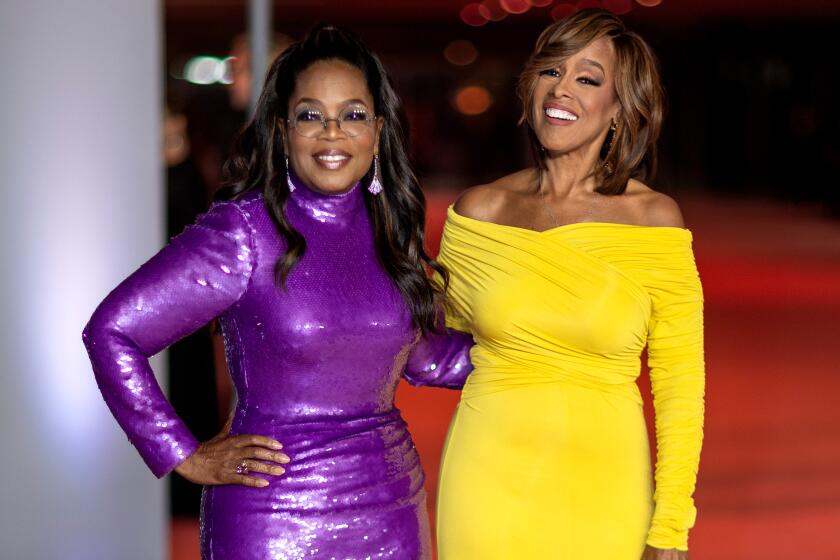Keepers of the Kovacs Flame : Television: A small growth industry has developed around salvaging the pioneer work of the late comedian Ernie Kovacs.
You have to wonder what Ernie Kovacs would have done with all of this, what kind of gleeful skit, what kind of satirical sketch, what kind of twist he would have put on what is happening in his name now.
For suddenly, it seems, it’s time again for “The Ernie Kovacs Show.” On several fronts--on television, on home videos, in special shows and exhibitions, and in books--Ernie Kovacs is being remembered, discovered and celebrated.
Would we have the Nairobi Trio grunting some muffled chant to his new popularity almost 30 years after his death in a Santa Monica Boulevard car crash? Would we have another totally silent television show to the frustration and worries of other frustrated and worried network executives? Would we have an outrageously new character, perhaps someone with an oversized cigar and mustache, satirizing himself?
Kovacs was one of the first great innovators when broadcast television was very young. He dared to be different and creative, usually working live while inventing visual effects and situations that became standards. “He experimented constantly,” his widow Edie Adams says. “He liked to play in the control room, staying there for hours.”
And the re-emergence and re-selling of Ernie Kovacs, 1991, has enough elements to make a show of its own.
In West Long Branch, N.J., we have Dennis Hedlund. He formed a new company, White Star, when he brought out the legal, authorized, non-pirated set of home videos, “The Best of Ernie Kovacs,” last month. It’s the fulfillment of a pledge Hedlund made a few years back. Fourteen years, ago he helped form Kultur (pronounced coal-tour), a home video company specializing in the arts: Rubinstein, Heifetz, Baryshnikov, Domingo, the Bolshoi performing on your VCR. But Hedlund, once a rock ‘n’ roll disc jockey, was also a Kovacs fan.
“He was my hero. But I knew him in spirit only,” Hedlund says. “I was 17 when he died, but when I first visited Los Angeles a few years later, the first thing I did was to visit his grave. There I pledged to him that I’d preserve his legacy with a video. And then I left him a cigar.”
Hedlund came through with his pledge: five videos, 10 half-hour shows, enhanced and cleaned up black-and-white tapes, Percy Dovetonsils, Wolfgang Sauerbraten and, with the special collector’s edition of all five videos, five Dutch Masters cigars.
* Then in Philadelphia, momentarily at least, there’s Edie Adams, appearing in another summer production of “Hello, Dolly!” She talks now about the many lessons she’s had to learn in the years since her husband died. She learned about being left alone and about continuing her career. She learned about fighting off the IRS with its liens against her husband’s estate. She learned about stopping pirated editions of Kovacs’ television shows, about rescuing and buying back the tapes, the films and the kinescopes. Kovacs worked for everyone who owned a television network plus a few independent stations. At one point, Edie Adams discovered one network using some of Kovacs’ tapes for retaping, in this case weather and some news reports. To stop that, she had to buy the material back.
Everything she bought was added to her husband’s personal collection in storage. In 1968, she and her secretary became amateur archivists, attempting to categorize everything in the collection. The job is yet undone.
“As it turns out it was the smartest thing I ever did, getting back the entire collection. We never really knew what we had here,” she says. “At one time we thought we had only outtakes and duplicate tapes. But we discovered 35-millimeter film from NBC in mint condition and from ABC two-inch tapes that covered Ernie’s shows from 1959 through 1961. We have material so old that the machines to play them on haven’t been around for years.”
Edie Adams has written about her years before and with Kovacs in her autobiography, “Sing a Pretty Song.” She’s working on a second book, the years following Kovacs’ death. When “Dolly” ends, she’ll go on another lecture tour of women’s groups, talking about working women’s issues, living alone and survival.
The revival of interest in her husband’s work pleases and amuses her but doesn’t surprise her. “We all learned from the best,” she says.
* Then in Hollywood there’s Gordon Smith of Gordon Smith Productions. He’s probably never been busier than in the past few years, for it’s his job to represent Edie Adams in the handling and licensing of the Kovacs collection.
Before closing the recent home-video deal, Smith completed one of the major transactions in the so-far short, happy life of Comedy Central, the cable network formed by the merger of the Comedy Channel and Ha!, negotiating a 10-year licensing deal for the entire 100-plus half-hour shows and specials stored away in an old Bekins storage building in Los Angeles.
“Kovacs is very hot now,” Smith says. Smith is now negotiating the sale of some of the library to foreign television and video distributors. He plans on getting comedian Mel Brooks to narrate the foreign tapes.
And there’s an HBO special on Kovacs that might include some of his feature film work as well as the classic television material.
There’s also an American Federation of the Arts touring show being discussed. It would be presented nationally at museums and colleges showing Kovacs’ work.
And then there’s a project being talked about at UCLA’s film archives, an effort to convert some of the collection to interactive laser discs, producing a visual textbook on the comedian’s career.
Ernie Kovacs interactive!
It’s enough to make you laugh.
And wonder.
If no one had invented cable. If no one had invented home videos and VCRs. If no one had thought of protecting the rights of one artist, would all of this had happened?
The complete guide to home viewing
Get Screen Gab for everything about the TV shows and streaming movies everyone’s talking about.
You may occasionally receive promotional content from the Los Angeles Times.



